
Jacksonville is the most populous city in Florida, and is the largest city by area in the contiguous United States as of 2020. It is the seat of Duval County, with which the city government consolidated in 1968. Consolidation gave Jacksonville its great size and placed most of its metropolitan population within the city limits. As of 2019, Jacksonville's population was estimated to be 911,507, making it the 12th most populous city in the U.S., the most populous city in the Southeast, and the most populous city in the South outside of the state of Texas. The Jacksonville metropolitan area has a population of 1,523,615 and is the fourth largest metropolitan area in Florida.

Riverside is a suburban village in Cook County, Illinois, United States. A significant portion of the village is in the Riverside Landscape Architecture District, designated a National Historic Landmark in 1970. The population of the village was 8,875 at the 2010 census. It is a suburb of Chicago, located roughly 9 miles (14 km) west of downtown Chicago and 2 miles (3 km) outside city limits.

Jerseyville is a city in Jersey County, Illinois, United States. As of the 2010 U.S. census, the city had a total population of 8,465. It is the county seat of Jersey County, and is the largest city in the county.

Jacksonville is a city in Morgan County, Illinois, United States. The population was 19,446 at the 2010 census. It is the county seat of Morgan County. It is home to Illinois College, Illinois School for the Deaf, and the Illinois School for the Visually Impaired.

Orangeville is a village in Stephenson County, Illinois. The population was 793 at the 2010 census, up from 751 in 2000. The area's earliest white settlers arrived in the year 1833, and the village was platted in 1851 by John Bower, who is considered the village founder. In 1867 Orangeville was incorporated as a village. The town's central business district contains several 19th century commercial buildings, many of which were built during the railroad boom of 1888–1914. By the time the Great Depression was ongoing, business in Orangeville had started to decline, with the last bank closing in 1932. Although recently infrastructure jumps have given back some of its old decor.

Plainfield is a village in Will and Kendall counties, Illinois, United States. The population was 39,581 at the 2010 census and an estimated 44,308 in 2019.

Seneca is a city in Oconee County, South Carolina, United States. The population was 8,102 at the 2010 census. It is the principal city of the Seneca Micropolitan Statistical Area, an (MSA) which includes all of Oconee County and which is further included in the greater Greenville-Spartanburg-Anderson, South Carolina Combined Statistical Area. Seneca was named for the nearby Cherokee town of Isunigu, known to the English as "Seneca Town".
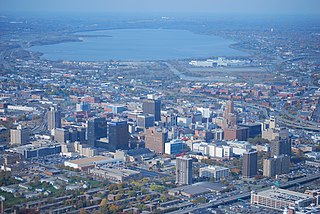
Downtown Syracuse is the economic center of Syracuse, New York, and Central New York, employing over 30,000 people, and housing over 4,000.
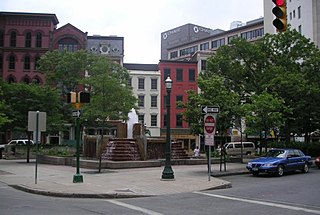
Hanover Square in downtown Syracuse is actually a triangle at the intersection of Warren, Water, and East Genesee Streets. The name may also refer to the larger Hanover Square Historic District which includes seventeen historic buildings in the area that was the first commercial district in Syracuse. In the warm weather months, entertainment is common on the plaza around the fountain. Workers in the surrounding office buildings and retail establishments often lunch there.

The Central Troy Historic District is an irregularly shaped, 96-acre (39 ha) area of downtown Troy, New York, United States. It has been described as "one of the most perfectly preserved 19th-century downtowns in the [country]" with nearly 700 properties in a variety of architectural styles from the early 19th to mid-20th centuries. These include most of Russell Sage College, one of two privately owned urban parks in New York, and two National Historic Landmarks. Visitors ranging from the Duke de la Rochefoucauld to Philip Johnson have praised aspects of it. Martin Scorsese used parts of downtown Troy as a stand-in for 19th-century Manhattan in The Age of Innocence.

Rodney Square is the public square and historic district in downtown Wilmington, Delaware, United States, named after American Revolutionary leader Caesar Rodney. A large statue of Rodney by James E. Kelly stands in the front of the square. The square was created in the early 20th century by John Jacob Raskob, who worked for Pierre S. du Pont. The City Beautiful movement served as the inspiration for the effort.

There are 68 properties listed on the National Register of Historic Places in Albany, New York, United States. Six are additionally designated as National Historic Landmarks (NHLs), the most of any city in the state after New York City. Another 14 are historic districts, for which 20 of the listings are also contributing properties. Two properties, both buildings, that had been listed in the past but have since been demolished have been delisted; one building that is also no longer extant remains listed.

Downtown Cincinnati contains the central business district of Cincinnati, Ohio, as well as a number of urban neighborhoods in the low land area between the Ohio River and the high land areas of uptown. These neighborhoods include Over-the-Rhine, Pendleton, Queensgate, and West End.

The Building at 202 W. Third Street, also known as the M.D. Petersen Estate Building, is a historic building located in downtown Davenport, Iowa, United States. It has been individually listed on the National Register of Historic Places since 1983. In 2020 it was included as a contributing property in the Davenport Downtown Commercial Historic District.
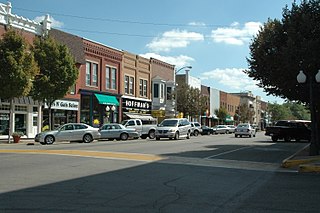
The Princeton South Main Street-Courthouse Square Historic District is a national historic district in Princeton, Illinois. Centered on South Main Street and the Bureau County Courthouse, the district is the older of the two downtown areas in Princeton, with the other being on North Main Street. Development in the area began with the settlement of Princeton in the 1830s and continued through the mid-twentieth century. The courthouse square was established when the county's first courthouse opened in 1845; the current Art Moderne courthouse was built there in 1937. South Main Street was considered the more upscale of Princeton's two downtowns, as it lacked the functional and agricultural businesses associated with the city's railroad station. The district's buildings reflect the popular architectural styles of the nineteenth and twentieth centuries; Italianate and Arts and Crafts designs are especially common, though Green Revival, Queen Anne, Neoclassical, Prairie School, and Moderne buildings are also present.
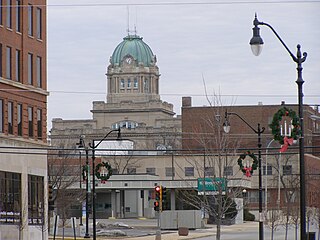
The Kankakee Downtown Historic District is a national historic district in downtown Kankakee, Illinois. The district includes 73 buildings which form the commercial and governmental center of the city, most of which are grouped along Court Street and Schuyler Avenue. While development in the district began in the 1850s, the oldest surviving building in the district is from 1864; the newest contributing buildings are from the mid-twentieth century. Kankakee's Courthouse Square and the 1908 Kankakee County Courthouse are part of the district; other government buildings in the district include Kankakee's post office, police and fire station, and armory. Most of the district's other buildings are one- to three-story brick or stone commercial buildings. Many popular architectural styles of the nineteenth and twentieth centuries are represented in the district; the Italianate, Neoclassical, and Art Deco styles are among the most common.

The Davenport Downtown Commercial Historic District is a nationally recognized historic district located in the central business district of Davenport, Iowa, United States. It was listed on the National Register of Historic Places in 2020. At the time of its nomination it consisted of 43 resources, which included 33 contributing buildings, one contributing structure, and nine non-contributing buildings. In addition, the district also contains 33 buildings that are individually listed on the National Register. This historic district is bordered by four other districts: the Crescent Warehouse Historic District and the Davenport Motor Row and Industrial Historic District on the east, the Hamburg Historic District to the northwest, and the West Third Street Historic District on the west.

The Downtown Peoria Historic District is a commercial historic district encompassing seventeen city blocks in downtown Peoria, Illinois. The district's buildings reflect Peoria's development as an industrial center and major Illinois city. While Peoria was platted in the 1820s, the oldest buildings in the district date from 1867, shortly before Peoria's economic boom of the 1870s. In the late nineteenth century, Peoria's whiskey industry was among the largest in the world, and many downtown civic improvements and public buildings were funded by whiskey profits. By the turn of the twentieth century, another economic boom brought a large retail district to downtown Peoria; many of the department stores from this period still stand in the district. An urban renewal project in the mid-twentieth century brought several Modernist skyscrapers to downtown Peoria as well, including the Caterpillar administration building, the DeKroff Metz and Company Building, and the First Federal Savings Tower.
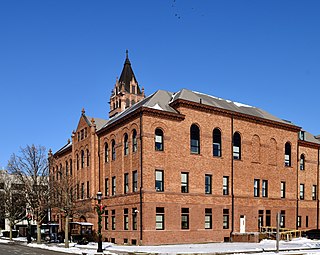
The Downtown Urbana Historic District is a commercial historic district encompassing seven city blocks in downtown Urbana, Illinois. The buildings in the district reflects downtown Urbana's development as the county seat of Champaign County and a regional commercial center. While Urbana was founded in the 1830s and began its development in the ensuing decades, the oldest buildings in the district are from the 1870s. The city expanded considerably in the late nineteenth and early to mid twentieth centuries, and most of the district's buildings were constructed during this period. Local architect Joseph Royer designed many of the district's most prominent buildings, including the 1901 Romanesque Revival Champaign County Courthouse.

The Champaign Downtown Commercial District is a commercial historic district encompassing 19.4 acres (7.9 ha) in downtown Champaign, Illinois. The district includes some of the oldest parts of the city's downtown, and its buildings represent the city's development in the late nineteenth and early twentieth centuries. Champaign was founded in the 1850s when the Illinois Central Railroad added a station in a rural area west of neighboring Urbana and the town formed around it; the oldest buildings in the district date from the following decade. Several buildings connected to the Illinois Central are included in the district. The opening of the University of Illinois at Urbana–Champaign in 1867 furthered Champaign's growth, and development in the downtown commercial district continued steadily through 1940. The district's commercial buildings exhibit a variety of building types and architectural styles, including Italianate, Art Deco, and various revival styles. Champaign's City Building and other local government buildings are also part of the district.






















